Penn State researchers have characterized over a hundred blazars from a catalog of previously unclassified high-energy cosmic emissions. This search challenges a controversial theory of blazar emissions.
When scientists tested the theory, it informed our understanding of black hole growth and even theories of general relativity and high-energy particle physics.
Stephen Kerby, a graduate student in astronomy and astrophysics at Penn State, said, “Because the jet of a blazar is pointed directly at us, we can see them from much farther away than other black hole systems, similar to how a flashlight appears brightest when you’re looking directly at it. Blazars are exciting to study because their properties allow us to answer questions about supermassive black holes throughout the universe. In this study, we used relatively new methods to characterize 106 dim blazars and test the predictions of a contentious theory called the ‘blazar sequence.'”
Astronomers generally observe two large peaks, one in gamma rays and one at lower-energy wavelengths, when examining studies of these emissions. These peaks have different wavelengths and intensities from blazar to blazar and throughout time. The “blazar sequence” is a general hypothesis of blazars that predicts that the lower-energy peak for brighter blazars will typically be redder and have lower energy than that of dimmer blazars. In contrast, the lower-energy peak for dim blazars will be bluer and higher energy.
Abe Falcone, research professor of astronomy and astrophysics and the lead of a high energy astrophysics group at Penn State, said, “Some of the most exciting and extreme blazars are discovered by detecting their gamma-ray emission, but we can’t usually classify or understand these objects without further multiwavelength observations.”
“With our currently operating telescopes, it’s very difficult to detect and classify the lower-energy peaked—red — blazars that are also dim, whereas it is much easier to find these blazars when their peaks are at higher energies or bright. So, with this research, we are minimizing a selection bias and exploring the blazar sequence by delving deeper into lower luminosities of both the low-energy and high-energy peaked blazars.”
Scientists identified blazars from a catalog of gamma-ray sources detected by the Fermi Large Area Telescope. Most of these sources had yet to be paired up with lower-energy emissions that may have come from the same source.
Then, using archived data, the researchers determined these counterpart emissions for each blazar in the infrared, radio, and optical bands observed by the Neil Gehrels Swift Observatory, whose Mission Operations Centre is based at Penn State. The researchers eventually described the spectra of 106 additional dim blazars by cross-referencing the data.
Kerby said, “The Swift telescope observations allowed us to pinpoint the positions of these blazars with much more precision than with the Fermi data alone. Pulling together all this emission data, combined with two new technical approaches, helped us identify where in the electromagnetic spectrum the low-energy peak occurs for each of the blazars, which, for example, can provide information about the strength of the jet’s magnetic field, how fast the charged particles are moving, and other information.”
The researchers utilized machine learning and direct physical fitting methodologies, each with benefits and drawbacks, to pinpoint where this peak for the dim blazars occurred. The machine-learning method filters out emissions that may genuinely be noise, such as light from neighboring stars or galactic dust. Although much more challenging to utilize and does not filter out noise, the direct physical fitting approach yields more precise blazar jet attributes.
Kerby said, “For both approaches, the emissions of our sample of dim blazars generally peaks in the blue, higher-energy light, though the fitting approach produced less extreme values. This agrees with the blazar sequence and extends what we know about this pattern. However, there are still a thousand Fermi unassociated sources for which we have found no X-ray counterpart, and it’s a fairly safe assumption that many of those sources are also blazars that are just too dim in the X-rays for us to detect. We can use the lessons we’ve learned here about the shape of these blazar’s spectra to make predictions about the blazars that are still too dim to detect, which would further test the blazar sequence.”
Journal Reference:
- Stephen Kerby and Abraham Falcone. Testing the Blazar Sequence with Spectra of Recently Discovered Dim Blazars from the Fermi Unassociated Catalog. The Astrophysical Journal. DOI: 10.48550/arXiv.2305.02087
